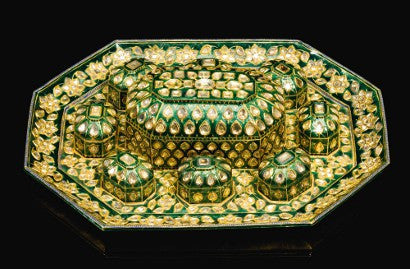An 18th century diamond and enamelled gold pandan box with an estimate of £200,000-300,000 ($320,586-480,879) is the highlight of a sale of Indian imperial art due to take place at Sotheby's London on October 9.
The pandan box, set on a tray with eight smaller boxes, was reputedly owned by the Nizam of Hyderabad - a former territory in south-eastern India. The bejewelled and enamelled pieces were designed not only as ornamentation but to impress and reinforce the power of the Nizam's empire.
 The pandan was reputedly owned by the Nizam of Hyderabad |
A large-scale painting titled The Adoration of Rama and Sita is another highlight. Dating to circa 1830-1840, the anonymous devotional work details the two sitting on a dais beneath a golden canopy. It is valued at £100,000-150,000 ($160,357-240,495).
The painting is set in the manner of a state portrait, and while such scenes were popular in Kangra, a former province in northern India with its own distinct style of painting, Shiva and Parvati were usually the subjects - making this example much rarer. Only one other example of a state portrait depicting Rama and Sita is known to exist.
A number of bejewelled weapons feature, most notably a dagger and scabbard from the Mughal empire circa 1700 with an estimate of £80,000-120,000 ($128,245-192,374).
The blade features a hilt in the shape of a split palmette and is covered in gemstones set in the Kundan fashion, a technique originating in the courts of Rajasthan and Gujarat where jewels are set into a gold or metal base.
A similar example sold in the US in 2006 for $260,000 against an $18,000 high estimate.
Sign up to our free weekly newsletter for more news and information on art and antiquities direct to your inbox.






